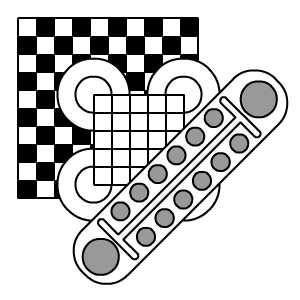| |

Board Game Studies Colloquium VIII
Abstracts
Richard Ballam
JAQUES BOARD GAMES, 1850-1900
In 1849 Jaques introduced the first Staunton pattern chess sets. Having
started in the eighteenth century as turners of wood and ivory by that time
they were making English pattern chess sets, draughts, backgammon, and a
series of turned wooden boards for games including The Mill (Nine Mens'
Morris), Fox and Geese, German Tactics, Three Garrisons and Knights Errant.
Rotarygammon was a form of circular backgammon protected by copyright in
1854. Imperial Contest was advertised in 1855 as invented by the late Rev.
Dr. Manson. It appears to be a version of the old Nordic game Heneftafl
dressed up to catch interest in the Crimean War. The rules for the
hexagonal game Agon or The Queen's Guard were published in 1842. The game
was subsequently taken up by Jaques.
The New Icosian Game, 1859, was invented by Sir William Hamilton and
advertised as 'especially interesting to students in mathematics'.
From about 1860 the floodgates seemed to open and a large number of board
games were produced and protected by registration. The Whitmore Jones
family contributed Hard Lines, 1860, War, c.1860, Frogs and Toads, 1863,
('The Chinese Imperial Game') and Mangola, 1863, (derived from Mancala), as
well as having contributed to Jaques a most successful game Squails, 1857
(derived from Carroms), and codifying the laws of Croquet in 1866.
A design for a Patchesi board was protected in 1863 and at that time also in
production were Numerals, 1859, Non Plus, Arena, Oxford University Boat
Race, 1861, The Royal Garrison Game, The Russian Bear Hunt, Rival Squadrons,
and Crusade.
There were also a series of race track boards for the Race Games
(Steeplechase). Folding mahogany boards were advertised priced up to £5,
circular mahogany to £2.10s, and millboard from 3s.6d.
In 1864 Hexagonia came out (which resembles hexagonal chess). Other early
board games (pre 1880) included The King of the Castle, Pontoons, Attack and
Defence, and Excelsior. The New Indian Game Goats and Tigers, the New Games
of Three Circles or Allied Colours and Go Bang also appeared.
After 1880 Jaques produced versions of the well known games Halma (including
Pirouette or Circular Halma), Reversi (including Royal or Cube Reversi), and
later Snakes and Ladders and Ludo (including Numerical Ludo), sometimes
battling with other firms to claim protected status. In 1885 Polemos
(second edition) was played at the Royal United Service Institution and
awarded a prize medal at the International Inventions Exhibition. Pictorial
board games were produced for race games (Wheeling, 'A new and exciting game
for cyclists' and Royal Mail 'From London to Edinburgh by L &N W Ry').
A three player game Shantu was advertised circa 1895 as 'A worthy successor
to Gobang, Reversi, Halma and other favourites'. Boer or Briton came out
with the advent of the Boer War, with Rengar 'Football as a board game',
Wasp, Hexagony, and Peelerino 'How to take a burglar to the police station'.
|

